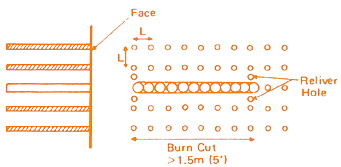Hole Design for Rocks
General Concepts For Breaking Of Boulders
| d | 38 - 44 mm |
| 1 1 / 2 "- 1 3 / 4 " | |
| D | 70 % of Height |
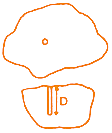
(Tensile Strength: < 60 kg/cm² : 85 psi)

(Tensile Strength: 60 - 100 kg/cm² : 80 - 140 psi)

(Tensile Strength: > 100 kg/cm² : 140 psi)
Underground Excavation
| d | 38 - 44 mm |
| 1½ "- 1¾ " | |
| L | 30 - 60 cm |
| 1 '- 2 ' | |
| D | Shown in Figure |
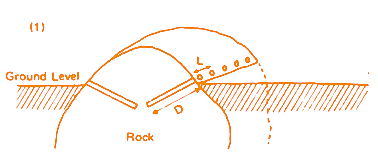
| d | 38 - 51 mm |
| 1½ "- 2 ' | |
| L | 60 - 90 cm |
| 2 '- 3 ' | |
| D | 90 % of Height |
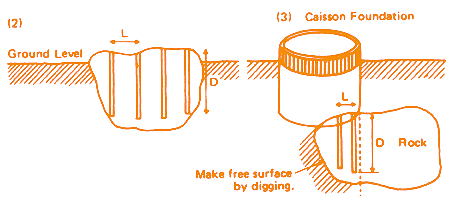
Splitting of Large Boulders
| d | 32 - 35 mm | 44 - 51 mm |
| 1¼ "- 1 3/8 " | 1¾ " - 2 " | |
| L | 30 - 40 cm | 60 - 90 cm |
| 1 '- 1 ' 4 " | 2 '- 3 ' | |
| D | 70 % of Height | |
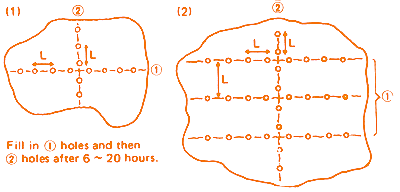
Cutting Into Slabs
| d | 32 - 35 mm | 44 - 51 mm |
| 1¼ "- 1 3/8 " | 1¾ " - 2 " | |
| L | 20 - 30 cm | 40 - 50 cm |
| 8 "- 1 ' | 1'4 "- 1'8" | |
| D | 90 % of Height | |
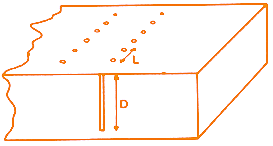
Breaking of Virgin Rock
| d | 44 - 51 mm |
| 1¾ " - 2 " | |
| L 1 | 30 - 40 cm |
| 1 '- 1'4" | |
| L 2 | 60 - 90 cm |
| 2 '- 3 ' | |
| D | Add 5 % of Height |
| 80° - 90° |
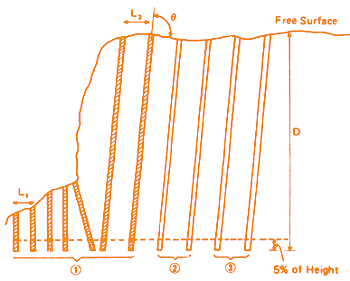
The toe should be drilled at closer hole spacing and successively broken from the front row. No drilling will cause poor breakage. The front holes (up to the sixth row) may be simultaneously filled in. It is more effective for removal to fill in one hole and then each two rows (2, 3) after a delay of 6 - 20 hours.
Trenching And Tunnelling
| d | 38 - 51 mm |
| 1½ "- 2 " | |
| L | 30 - 60 cm |
| 1 '- 2 ' | |
| D | 1 - 1.8 m |
| 3 '- 6 ' | |
| 45° - 60° |
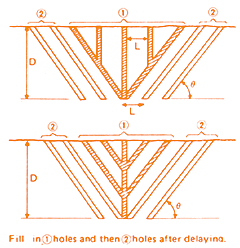
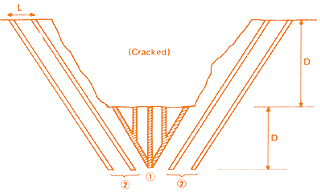
| d | 38 - 51 mm |
| 1½ "- 2 ' | |
| L 1 | 40 - 60 cm |
| 1'4 "- 2 ' | |
| L 2 | 30 - 40 cm |
| 1 '- 1'4" | |
| D | 1 - 1.8 m |
| 3 '- 6 ' |
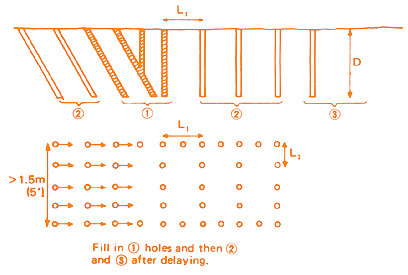
| d | 38 - 44 mm |
| 1½ "- 1¾ " | |
| L | 30 - 60 cm |
| 1 '- 2 ' |
